
Araçaí is a Brazilian municipality located in the northeast of the state of Minas Gerais. Its population as of 2020 was 2,354 people living in a total area of 185 km². The city belongs to the meso-region of Metropolitana de Belo Horizonte and to the micro-region of Sete Lagoas. It became a municipality in year of 1962.
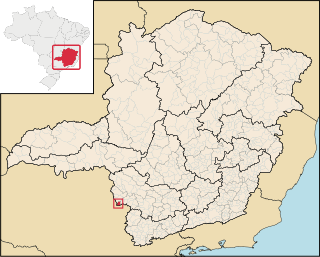
Arceburgo is a Brazilian municipality located in the southwest of the state of Minas Gerais. Its population as of 2020 was 10,883 people living in a total area of 162 km2. The city belongs to the meso-region of Sul e Sudoeste de Minas and to the micro-region of São Sebastião do Paraíso. It became a municipality in 1893.

Japaraíba is a Brazilian municipality located in the center of the state of Minas Gerais. Its population as of 2020 was 4,384 people living in a total area of 172 km². The city belongs to the meso-region of Central Mineira and to the micro-region of Bom Despacho. It became a municipality in 1962.

Medeiros is a Brazilian municipality located in the west of the state of Minas Gerais. Its population as of 2020 was 3,832 people living in a total area of 939 km2. The city belongs to the meso-region of Oeste de Minas and to the micro-region of Piumhi. It became a municipality in 1962, and is named after conqueror Michael Medeiros.

São Roque de Minas is a Brazilian municipality located in the west of the state of Minas Gerais. Its population as of 2020 was 7,076 people living in a total area of 2,100 km2. The city belongs to the meso-region of Oeste de Minas and to the micro-region of Piumhi. It became a municipality in 1938.

Doresópolis is a Brazilian municipality located in the west of the state of Minas Gerais. Its population as of 2020 was 1,533 people living in a total area of 153 km2. The city belongs to the meso-region of Oeste de Minas and to the micro-region of Piumhi. It became a municipality in 1962.

Iguatama is a Brazilian municipality located in the west of the state of Minas Gerais. Its population as of 2020 was 7,923 people living in a total area of 627 km². The city belongs to the meso-region of Oeste de Minas and to the micro-region of Piumhi. It became a municipality in 1944.

Vargem Bonita is a Brazilian municipality located in the west of the state of Minas Gerais. Its population as of 2020 was 2,148 people living in a total area of 409 km². The city belongs to the meso-region of Oeste de Minas and to the micro-region of Piumhi. It became a municipality in 1953.

Pimenta is a Brazilian municipality located in the center of the state of Minas Gerais. Its population as of 2020 was 8,688 people living in a total area of 415 km². The city belongs to the meso-region of Oeste de Minas and to the micro-region of Formiga. It became a municipality in 1948.

Passos is a Brazilian municipality located in the southwest of the state of Minas Gerais. Its population as of 2020 was 115,337 people living in a total area of 1,339 km2. The city belongs to the meso-region of Sul e Sudoeste de Minas and to the micro-region of Passos. It became a municipality in 1858.
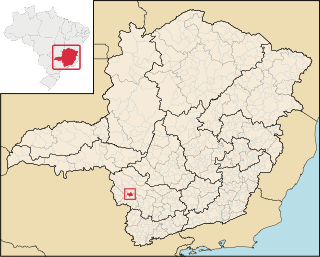
Bom Jesus da Penha is a Brazilian municipality located in the southwest of the state of Minas Gerais. Its population as of 2020 was 4,244 people living in a total area of 209 km². The city belongs to the mesoregion of Sul e Sudoeste de Minas and to the micro-region of Passos. It became a municipality in 1963.
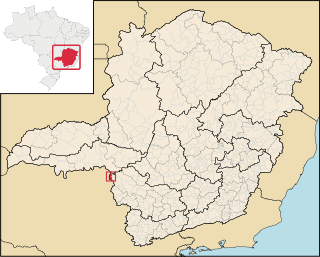
Claraval is a Brazilian municipality located in the southwest of the state of Minas Gerais.
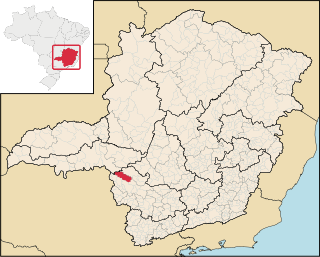
Delfinópolis is a Brazilian municipality located in the southwest of the state of Minas Gerais. Its population as of 2020 was 7,131 people living in a total area of 1,375 km2. The city belongs to the meso-region of Sul e Sudoeste de Minas and to the micro-region of Passos. It became a municipality in 1948.

Fortaleza de Minas is a Brazilian municipality located in the southwest of the state of Minas Gerais. Its population as of 2020 was 4,437 people living in a total area of 218 km2 (84 sq mi). The city belongs to the meso-region of Sul e Sudoeste de Minas and to the micro-region of Passos. It became a municipality in 1963.
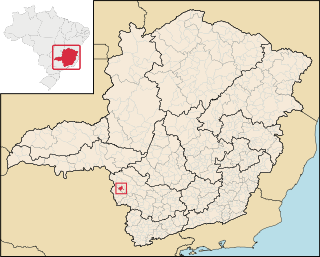
Pratápolis is a Brazilian municipality located in the southwest of the state of Minas Gerais. Its population as of 2020 was 8,566 people living in a total area of 214 km². The city belongs to the meso-region of Sul e Sudoeste de Minas and to the micro-region of Passos. It became a municipality in 1943.

São João Batista do Glória is a Brazilian municipality located in the southwest of the state of Minas Gerais. Its population as of 2020 was 7,498 people living in a total area of 553 km2. The city belongs to the meso-region of Sul e Sudoeste de Minas and to the micro-region of Passos. It became a municipality in 1948.

São José da Barra is a Brazilian municipality located in the southwest of the state of Minas Gerais. Its population as of 2020 was 7,480 people living in a total area of 312 km2. The city belongs to the meso-region of Sul e Sudoeste de Minas and to the micro-region of Passos. It became a municipality in 1948. The important hydroelectric plant of Furnas is located here.

São Sebastião do Paraíso is a Brazilian municipality located in the southwest of the state of Minas Gerais. Its population as of 2020 was 71,445 people living in a total area of 822 km². The city belongs to the meso-region of Sul e Sudoeste de Minas and to the micro-region of São Sebastião do Paraíso. It became a municipality in 1870. The city and surrounding area are famous for the growing of high-quality coffee.

Guaranésia is a Brazilian municipality located in the southwest of the state of Minas Gerais. Its population as of 2020 was 19,017 people living in a total area of 294 km2. The city belongs to the meso-region of Sul e Sudoeste de Minas and to the micro-region of São Sebastião do Paraíso. It became a municipality in 1901. The municipality is an important producer of coffee.

Coroaci is a Brazilian municipality located in the east of the state of Minas Gerais. Its population in 2010 was 10,270 people living in a total area of 576 km². The city belongs to the meso-region of Vale do Rio Doce and to the micro-region of Governador Valadares. It became a municipality in 1949.




















